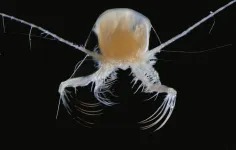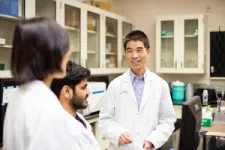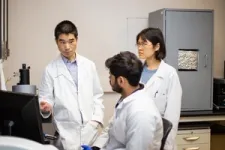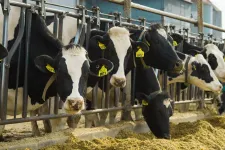(Press-News.org) The diet quality of fish across large parts of the world’s oceans could decline by up to 10 per cent as climate change impacts an integral part of marine food chains, a major study has found.
QUT School of Mathematical Sciences researcher Dr Ryan Heneghan led the study published in Nature Climate Change that included researchers from the University of Queensland, University of Tasmania, University of NSW and CSIRO.
They modelled the impact of climate change on zooplankton, an abundant and extremely diverse group of microscopic animals accounting for about 40 per cent of the world’s marine biomass.
Zooplankton are the primary link between phytoplankton—which convert sunlight and nutrients into energy like plants do on land—and fish. Zooplankton include groups such as Antarctic krill—a major food source for whales—and even jellyfish.
“Despite their abundance, diversity and critical importance in transferring energy from phytoplankton to fish, knowledge about what shapes the composition of zooplankton communities across the world’s oceans is relatively limited,” Dr Heneghan said.
“This is a challenge, since if zooplankton are affected by climate change, this could have important implications for the ocean’s ability to sequester carbon emissions, and the productivity of fisheries.”
The research team used a global marine ecosystem model to look at the impact of climate change on the major zooplankton groups, from single-cell zooplankton, to krill, and all the way up to jellyfish.
“We used the model to project changes in the zooplankton community in response to climate change, and then assess how these changes could affect the diet quality of small fish—the primary predators of zooplankton beyond the zooplankton themselves,” Dr Heneghan said.
“We found future climate change drives shifts in the composition of zooplankton communities across most of the world’s oceans. These changes were mostly caused by decreases in the size of phytoplankton under climate change.”
The researchers found future zooplankton communities will be increasingly dominated by carnivorous groups, such as chaetognaths, and gelatinous groups, such as salps and larvaceans, at the expense of small crustacean omnivores such as krill and copepods.
“In the oceans, energy is transferred from microscopic plankton up to fish and whales by size-based predation—big things eating small things,” Dr Heneghan said.
Like blue whales, which eat krill, gelatinous salps and larvaceans eat prey millions of times smaller than themselves, which means unlike other larger zooplankton eaten by fish, they can directly access smaller phytoplankton for food.
As a result, salps and larvaceans provide an effective shortcut for the transfer of energy from increasingly dominant small phytoplankton to fish.
“This shortcut partially offsets the increase in the number of steps from phytoplankton to fish from shrinking phytoplankton and increases in carnivorous zooplankton,” Dr Heneghan said.
“But, it comes at a cost: these groups are gelatinous, having about five per cent of the carbon contained in omnivorous zooplankton such as krill and copepods.
“In terms of nutrition, this would be like replacing a rib-eye steak with a bowl of jelly.
“As a result, our model projects that the diet quality of small fish could decline across large areas of the world’s oceans, which would exacerbate declines in fish biomass from climate change by up to 10 per cent.”
Dr Heneghan said shifts to more gelatinous fish diets had already been observed during a recent marine heatwave in the North Pacific, commonly called “the Blob”.
“The higher temperatures drove declines in phytoplankton production, which in turn drove decreases in the prevalence of carbon-dense krill, which were replaced by gelatinous zooplankton,” he said.
“As a result, small fish in the region shifted to more gelatinous diets, which drove declines in their weight and abundance.
“Our model results indicate the shift to more gelatinous diets for small fish could become more common in the future under ocean warming.
“For human societies, the this could have far-reaching implications globally, since according to the United Nations Food and Agriculture Organization fisheries are a key ecosystem service worth US$150 billion a year and providing more than 20 per cent of dietary animal protein for 3.3 billion people, and supporting 60 million livelihoods.”
The research team included Dr Heneghan, Dr Jason Everett, Professor Julia Blanchard, Patrick Sykes and Professor Anthony Richardson.
END
Climate change threatens global fisheries
Queensland University of Technology
2023-03-23
ELSE PRESS RELEASES FROM THIS DATE:
Dairy sector boasts 100 years of successful herd data collection
2023-03-23
URBANA, Ill. – The U.S. dairy industry operates a comprehensive data collection program that records herd production information from farmers nationwide. The program provides crucial input for cattle breeding and genetics, and its cooperative structure ensures benefits for producers and scientists alike. A new study from the University of Illinois explores the program’s century-old history, highlighting its relevance for modern agriculture and digital data collection.
“The National Cooperative Dairy Herd Improvement Program (NCDHIP) is an interesting case study because it illustrates how to translate the benefits ...
Study: Mapping people’s knowledge of bees may aid in pollinator conservation
2023-03-23
UNIVERSITY PARK, Pa. — U.S. college students’ knowledge of bees focuses primarily on honey bees and pollination services, according to Penn State researchers, who said findings from their recent study could help in designing campaigns to generate support for protecting threatened pollinators.
Wild and managed bee populations have been in steep decline worldwide in recent years, noted study co-author Christina Grozinger, Publius Vergilius Maro Professor of Entomology and director of the Center for Pollinator Research in ...
Spectroscopy probe could enhance deep brain stimulation procedure for Parkinson’s
2023-03-23
VANCOUVER -- Deep brain stimulation (DBS) has become an increasingly common treatment for patients with advanced Parkinson’s disease, but the procedure still carries significant risks. A new probe that performs two types of spectroscopy could make the procedure safer and improve success rates by helping doctors more accurately navigate instruments inside the brain. The research team identified white and grey matter using principal component analysis (PCA), proving that spectroscopic measurements could be suitable for neuronavigation.
For DBS, surgeons place electrodes in the brain to disrupt the errant signals that cause debilitating tremors and stiffness associated ...
Habitat will dictate whether ground beetles win or lose against climate change
2023-03-23
UNIVERSITY PARK, Pa. — The success of North American crops from corn to Christmas trees partly depends on a relatively invisible component of the food web — ground beetles. Nearly 2,000 species of ground beetle live in North America. New research led by Penn State shows that some of these insects could thrive while others could decline as the climate changes. The team found that the response will largely depend on the species’ traits and habitats and could have significant implications for conservation efforts.
“We know that climate change influences everything from coral reefs in the ocean to trees on land, but there’s ...
CDC report shows overall and Maryland autism rate increase among 8-year-olds
2023-03-23
Researchers at the Johns Hopkins Bloomberg School of Public Health contributed to a new Centers for Disease Control and Prevention report that found a continued rise in the overall prevalence of autism among 8-year-olds in 2020, the year the data was collected, as well as notable sex and racial/ethnic trends. In Maryland, the autism rate among 8-year-olds also rose, but it was the lowest prevalence among 11 sites that contributed to the study.
Autism spectrum disorder (ASD) is a developmental disorder that can be characterized by social and communication challenges, along with limited interests and repetitive behaviors.
The prevalence of ASD has risen steadily ...
Court ruling on PrEP could lead to more than 2,000 HIV infections in the next year
2023-03-23
A recent U.S. federal court ruling that removes a requirement for employers to provide insurance coverage for the HIV prevention medications known as Pre-Exposure Prophylaxis, or PrEP, could result in more than 2,000 entirely preventable HIV infections in the coming year, according to a new study led by researchers at the Yale School of Public Health.
The study addresses the potential consequences of a September 2022 decision by U.S. District Judge Reed O’Connor of Texas in a case known as Braidwood Management v. Becerra. O’Connor ruled in favor of the plaintiffs, a group of Christian business owners who claimed that federal mandates requiring private insurance ...
USC Norris collaborates with Auransa on clinical trial of new targeted treatment for liver cancer and other solid tumors
2023-03-23
The University of Southern California (USC) is collaborating with Auransa Inc., on a phase 1 clinical trial to evaluate a new kind of treatment for cancers of the liver and solid tumors with liver dominant disease. The drug, known as AU409, was developed by Auransa, a clinical stage drug development company focused on identifying novel drug candidates for oncology, inflammatory diseases and diseases of the central nervous system. In preclinical trials, AU409, has been shown to work in a unique fashion by limiting the cancer cell’s ability to translate the message from various genes ...
Global natural history initiative builds groundbreaking database to address 21st century challenges
2023-03-23
March 23, 2023 – Washington, DC, New York, NY, and London, England – A group of natural history museums, organized by the Smithsonian National Museum of Natural History in Washington DC, the American Museum of Natural History Museum in New York City, and the Natural History Museum in London, has mapped the total collections from 73 of the world’s largest natural history museums in 28 countries. This is the first step of an ambitious effort to inventory global holdings that can help scientists and decisionmakers find solutions to urgent, wide-ranging issues such as climate ...
Eye color genes are critical for retinal health
2023-03-23
Metabolic pathways consist of a series of biochemical reactions in cells that convert a starting component into other products. There is growing evidence that metabolic pathways coupled with external stress factors influence the health of cells and tissues. Many human diseases, including retinal or neurodegenerative diseases, are associated with imbalances in metabolic pathways. Elisabeth Knust leads a team of researchers from the Max Planck Institute of Molecular Cell Biology and Genetics (MPI-CBG) in Dresden, Germany, who describe an essential role for one ...
Can insights from the soapbark tree change the way we make vaccines?
2023-03-23
The medicinal secrets of the Chilean soapbark tree have been laid bare, unlocking a future of more potent, affordable, and sustainably sought vaccines.
The evergreen species, Quillaja saponaria has, for decades, been highly prized for producing molecules called QS saponins, which are used in the food and drinks industry as foaming agents.
More recently an important new function has emerged with saponins obtained from the tree’s bark used as potent adjuvants in the production of vaccines. Adjuvants play a critical role in some vaccines, working to boost the potency of a vaccine by enhancing the host immune response.
Molecules extracted from soapbark tree are ...
LAST 30 PRESS RELEASES:
Making lighter work of calculating fluid and heat flow
Normalizing blood sugar can halve heart attack risk
Lowering blood sugar cuts heart attack risk in people with prediabetes
Study links genetic variants to risk of blinding eye disease in premature infants
Non-opioid ‘pain sponge’ therapy halts cartilage degeneration and relieves chronic pain
AI can pick up cultural values by mimicking how kids learn
China’s ecological redlines offer fast track to 30 x 30 global conservation goal
Invisible indoor threats: emerging household contaminants and their growing risks to human health
Adding antibody treatment to chemo boosts outcomes for children with rare cancer
Germline pathogenic variants among women without a history of breast cancer
Tanning beds triple melanoma risk, potentially causing broad DNA damage
Unique bond identified as key to viral infection speed
Indoor tanning makes youthful skin much older on a genetic level
Mouse model sheds new light on the causes and potential solutions to human GI problems linked to muscular dystrophy
The Journal of Nuclear Medicine ahead-of-print tip sheet: December 12, 2025
Smarter tools for peering into the microscopic world
Applications open for funding to conduct research in the Kinsey Institute archives
Global measure underestimates the severity of food insecurity
Child survivors of critical illness are missing out on timely follow up care
Risk-based vs annual breast cancer screening / the WISDOM randomized clinical trial
University of Toronto launches Electric Vehicle Innovation Ontario to accelerate advanced EV technologies and build Canada’s innovation advantage
Early relapse predicts poor outcomes in aggressive blood cancer
American College of Lifestyle Medicine applauds two CMS models aligned with lifestyle medicine practice and reimbursement
Clinical trial finds cannabis use not a barrier to quitting nicotine vaping
Supplemental nutrition assistance program policies and food insecurity
Switching immune cells to “night mode” could limit damage after a heart attack, study suggests
URI-based Global RIghts Project report spotlights continued troubling trends in worldwide inhumane treatment
Neutrophils are less aggressive at night, explaining why nighttime heart attacks cause less damage than daytime events
Menopausal hormone therapy may not pose breast cancer risk for women with BRCA mutations
Mobile health tool may improve quality of life for adolescent and young adult breast cancer survivors
[Press-News.org] Climate change threatens global fisheriesQueensland University of Technology







